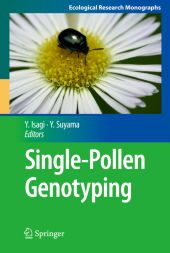 Neuerscheinungen 2014Stand: 2020-02-01 |
Schnellsuche
ISBN/Stichwort/Autor
|
Herderstraße 10
10625 Berlin
Tel.: 030 315 714 16
Fax 030 315 714 14
info@buchspektrum.de |

Yuji Isagi, Yoshihisa Suyama
(Beteiligte)
Single-Pollen Genotyping
Herausgegeben von Isagi, Yuji; Suyama, Yoshihisa
2011. 2014. xi, 127 S. 13 Tabellen. 235 mm
Verlag/Jahr: SPRINGER, BERLIN; SPRINGER JAPAN; SPRINGER 2014
ISBN: 4-431-54723-1 (4431547231)
Neue ISBN: 978-4-431-54723-5 (9784431547235)
Preis und Lieferzeit: Bitte klicken
This book provides a detailed description of the principle and method of single-pollen genotyping. It presents the experimental protocol and several applications of this method in studies on plant ecology and evolution.
Pollination is one of the most important processes in plant reproduction. It directly influences reproductive success and fitness and the genetic structure of the plant population. Methods exist to infer the pattern and distance of pollen dispersal, but direct observation of the movements of individual pollen grains during pollination is not feasible owing to their small size. Single-pollen genotyping is a novel technique for genotyping a single pollen grain. In this book, the principles, the experimental protocol, and several applications of this method in studies of plant ecology, reproductive biology, and evolutionary genetics have been described. More specifically, the information is useful for the analysis of linkage disequilibrium, intraspecific genetic variation, chromosome mapping, and the origins of polyploidy. It is also essential for achieving sustainable and optimal crop yield and is vital to agriculture and forestry. Written by pioneer researchers, the book provides novel research approaches that are proving useful in a growing number of fields. This volume is intended to encourage new and continued applications of single-pollen genotyping among many disciplines in the future.
1 Signifi cance of Single-Pollen Genotyping in Ecological Research.- 2 Procedure for Single-Pollen Genotyping.- 3 Pollination Effi ciencies of Insects Visiting Magnolia obovata, as Determined by Single-Pollen Genotyping.- 4 Difference in Pollen Donor Composition During the Early Phases of Reproduction as Revealed by DNA Analysis of Pollen Grains and Seeds in the Monoecious Tree Castanea crenata.- 5 Expanded Home Range of Pollinator Birds Facilitates Greater Pollen Flow of Camellia japonica in a Forest Heavily Damaged by Volcanic Activity.- 6 Can Tiny Thrips Provide Suffi cient Pollination Service During a General Flowering Period in Tropical Rainforest?- 7 Alien Dandelions Displace a Native Related Species Through Interspecifi c Pollen Transfer.- 8 Single-Pollen Genotyping of Holocene Lake Sediments.- 9 Potential Application of Pollen Genotyping for Evolutionary Genetic and Genomic Studies: Linkage/Recombination Analysis and Haplotype Sequencing.- Index.
From the reviews:
"Patterns of pollen dispersal and probabilities of cross pollination are possible to predict but this short book (127 pages) looks at a useful new technique whereby the genotype of single pollen grains can be identified. ... this technique allowed the researchers to not only identify whether pollen was being carried from species to species but also to estimate how much of the pollen on a flower was from the same trees or from others, and hence the potential degree of self pollination." (Peter Thomas, Bulletin of the British Ecological Society, Vol. 42 (2), 2011)


